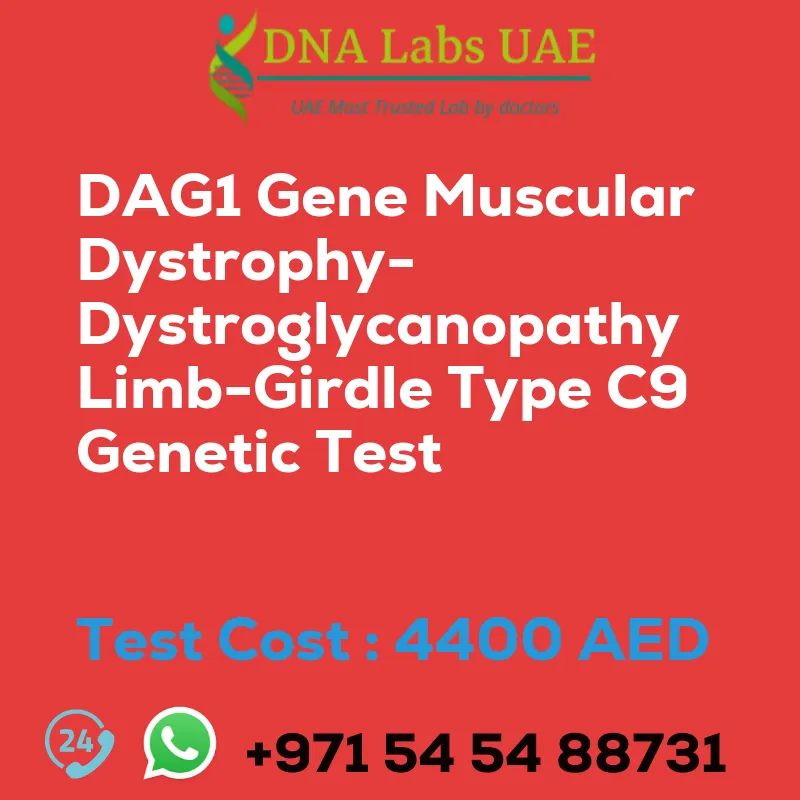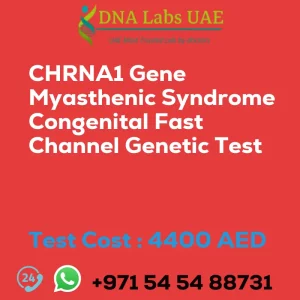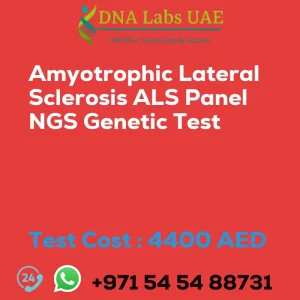DAG1 Gene Muscular Dystrophy-Dystroglycanopathy Limb-Girdle Type C9 Genetic Test
Test Details
DAG1 gene muscular dystrophy-dystroglycanopathy (limb-girdle), type C9 is a specific type of muscular dystrophy that is caused by mutations in the DAG1 gene. This gene provides instructions for making a protein called alpha-dystroglycan, which is involved in maintaining the structure and function of muscle cells.
NGS (Next-Generation Sequencing) genetic testing is a type of genetic test that uses advanced sequencing technology to analyze multiple genes simultaneously. In the case of DAG1 gene muscular dystrophy-dystroglycanopathy (limb-girdle), type C9, NGS genetic testing can identify mutations or variations in the DAG1 gene that may be responsible for the condition.
This type of genetic testing can help in the diagnosis of DAG1 gene muscular dystrophy-dystroglycanopathy (limb-girdle), type C9 by identifying specific genetic changes that are known to be associated with the condition. It can also provide information about the inheritance pattern of the condition, which can be useful for genetic counseling and family planning.
Test Name
DAG1 Gene Muscular Dystrophy-Dystroglycanopathy Limb-Girdle Type C9 Genetic Test
Components
Price: 4400.0 AED
Sample Condition
Blood or Extracted DNA or One drop Blood on FTA Card
Report Delivery
3 to 4 Weeks
Method
NGS Technology
Test Type
Neurological Disorders
Doctor
Neurologist
Test Department
Genetics
Pre Test Information
Clinical History of Patient who is going for DAG1 Gene Muscular Dystrophy-Dystroglycanopathy (Limb-Girdle), Type C9 NGS Genetic DNA Test
A Genetic Counselling session to draw a pedigree chart of family members affected with DAG1 Gene Muscular Dystrophy-Dystroglycanopathy (Limb-Girdle), Type C9
Test Process
NGS genetic testing for DAG1 gene muscular dystrophy-dystroglycanopathy (limb-girdle), type C9 is typically performed using a blood or saliva sample. The sample is sent to a laboratory where the DNA is extracted and analyzed using sequencing technology.
Result and Treatment
The results of the test can then be used by healthcare professionals to confirm a diagnosis and provide appropriate management and treatment options for individuals with this condition.
| Test Name | DAG1 Gene Muscular dystrophy-dystroglycanopathy limb-girdle type C9 Genetic Test |
|---|---|
| Components | |
| Price | 4400.0 AED |
| Sample Condition | Blood or Extracted DNA or One drop Blood on FTA Card o |
| Report Delivery | 3 to 4 Weeks |
| Method | NGS Technology |
| Test type | Neurological Disorders |
| Doctor | Neurologist |
| Test Department: | Genetics |
| Pre Test Information | Clinical History of Patient who is going for DAG1 Gene Muscular dystrophy-dystroglycanopathy (limb-girdle), type C9 NGS Genetic DNA Test A Genetic Counselling session to draw a pedigree chart of family members affected with DAG1 Gene Muscular dystrophy-dystroglycanopathy (limb-girdle), type C9 |
| Test Details |
DAG1 gene muscular dystrophy-dystroglycanopathy (limb-girdle), type C9 is a specific type of muscular dystrophy that is caused by mutations in the DAG1 gene. This gene provides instructions for making a protein called alpha-dystroglycan, which is involved in maintaining the structure and function of muscle cells. NGS (Next-Generation Sequencing) genetic testing is a type of genetic test that uses advanced sequencing technology to analyze multiple genes simultaneously. In the case of DAG1 gene muscular dystrophy-dystroglycanopathy (limb-girdle), type C9, NGS genetic testing can identify mutations or variations in the DAG1 gene that may be responsible for the condition. This type of genetic testing can help in the diagnosis of DAG1 gene muscular dystrophy-dystroglycanopathy (limb-girdle), type C9 by identifying specific genetic changes that are known to be associated with the condition. It can also provide information about the inheritance pattern of the condition, which can be useful for genetic counseling and family planning. NGS genetic testing for DAG1 gene muscular dystrophy-dystroglycanopathy (limb-girdle), type C9 is typically performed using a blood or saliva sample. The sample is sent to a laboratory where the DNA is extracted and analyzed using sequencing technology. The results of the test can then be used by healthcare professionals to confirm a diagnosis and provide appropriate management and treatment options for individuals with this condition. |








